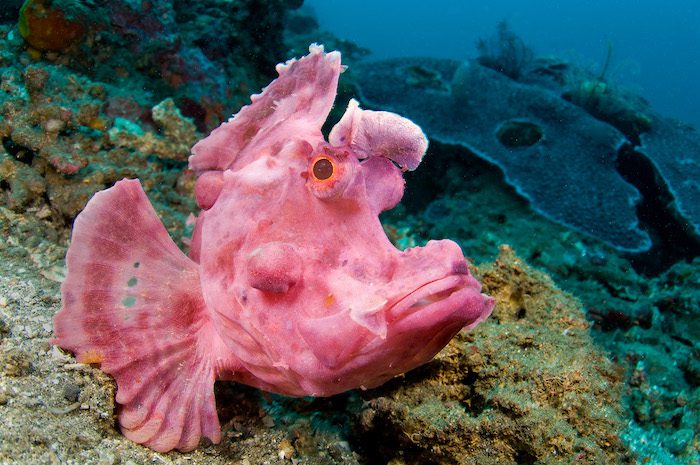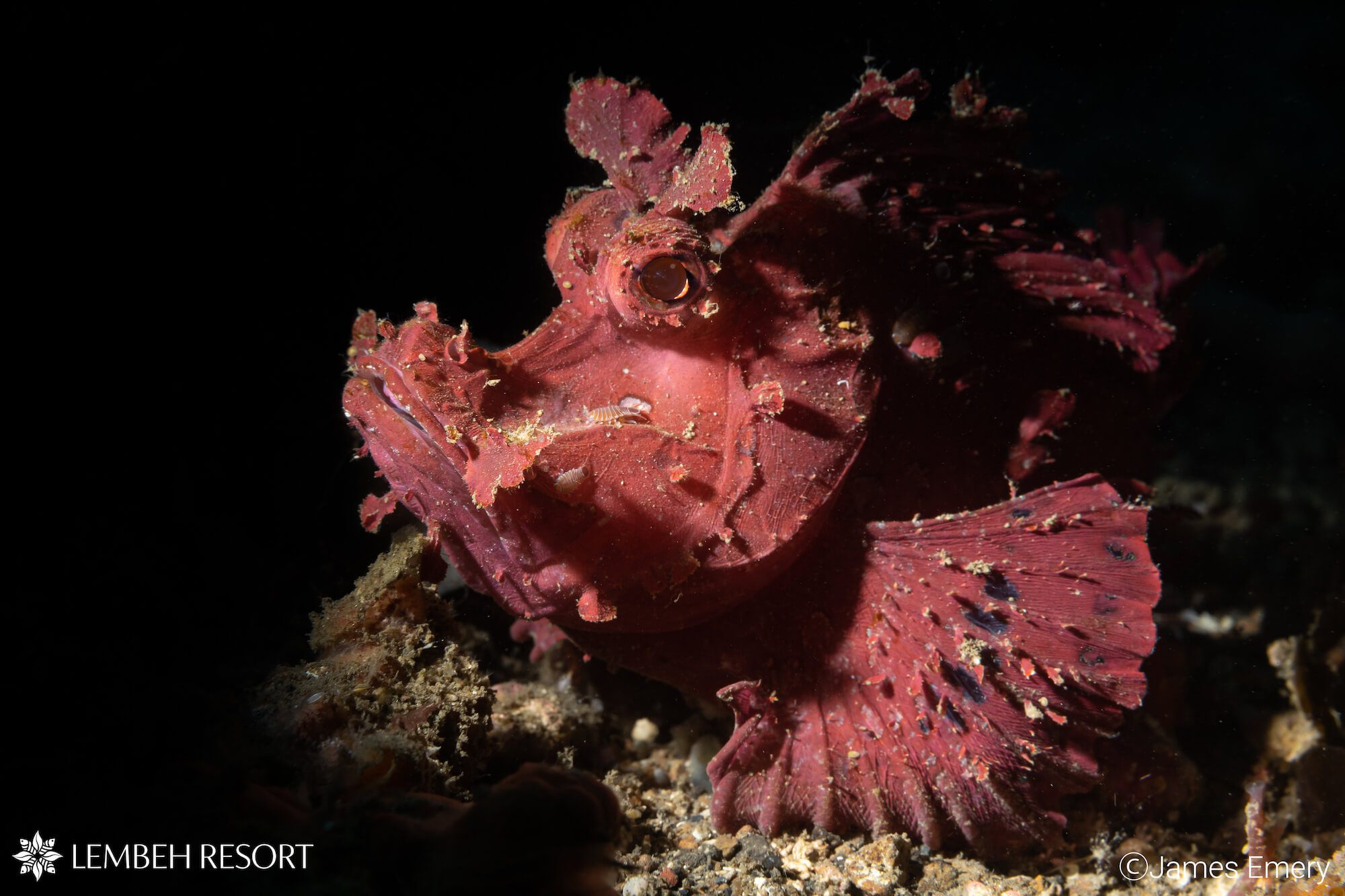Paddle Flap Scorpionfish (Rhinopias eschmeyeri)

Rhinopias belong to the scorpionfish family and are native to the tropical western Indo-Pacific. Like all scorpionfish, they have venomous spines and prefer to rest on the bottom, occasionally walking or ‘hopping’ by pushing off with their pelvic and pectoral fins rather than swimming.
Scorpionfish are masters of camouflage, enabling them to lie in wait for their victims to come close, before lunging forward and inhaling their prey with their large mouths. Read on to find out more…
Physical Characteristics
The paddle flap, like all scorpionfish have venomous spines and short fins. They have 12 spines on their dorsal fins and 3 spines in their anal fins. Their pectoral fins contain 12-18 fin rays with the lower rays being thickened. The soft fin rays of the dorsal and anal fins, as well as the upper fin rays of the pectoral fins, are branched.
They can adapt their color to blend in with their marine environment, most commonly we see pink, orange, white and grey. They have appendages over their eyes that give them the appearance of having eyebrows. They have a slightly comical look with their ‘eyebrows’ and ‘mustaches’.
Paddle Flap Rhinopias Behavior
When we spot a paddle flap it is usually sitting on the seafloor, they are not open water swimmers. Instead of swimming they ‘walk’ or ‘hop’ along the sea floor. They hide in plain sight and wait for prey to come to them. For this reason, they tend to stay very still and do not travel large distances.

Rhinopias in the Lembeh Strait by Alex Mustard
Feeding
Rhinopias have the ability to expand their mouths and suck in their prey – and swallow it whole! They mainly feed on small fish, crustacean flesh, clams, and other marine meaty foods.
Habitat
Rhinopias are most commonly found on soft sea bottoms which can include reefs, sea grasses, and soft sand. Because of their hunting habits, they are usually hiding and utilizing whatever camouflage they can find.
Reproduction
As with most acts of marine species mating, the foreplay takes up the majority of the activity with the actual spawning ascent only taking a few seconds. The male will release an ejection of sperm while the female sends out a floating egg raft. If the eggs are successfully fertilized then the larvae will drift with the ocean currents until they are large enough that they will sink to the ocean floor.
Blackwater Diving
If you join us for a blackwater dive during your stay, this is also one of the best opportunities to see drifting larvae – a totally unique diving experience.
Rhinopias and Underwater Photography
When trying to capture images of rhinopias it is important to approach slowly and with caution so as not to threaten the animal and disturb its natural behavior. Aim to position yourself close to the bottom – the higher up you are, the bigger you will appear and the greater the perceived threat. As with most critters in the Lembeh Strait, stay low, go slow, and get closer!
Rhinopias are a great opportunity to try working on your close-focus wide angle photography skills too!
Tip: Aim to get as close as you can and avoid using the digital zoom function which will result in a more grainy and pixelated image. If you are able to approach in increments and take shots at each stage you will have a flow of images to work with during post-shooting editing.

James Emery: Rhinopias paddle flap
Where to Find Paddle Flap Rhinopias in Lembeh
One of the best dive sites in the Lembeh Strait for spotting the paddle flap rhinopias is Nudifalls. At Nudifalls there is a deeper area that has a beautiful soft coral garden which provides them with amazing habitat to nestle in.
This is also a great site for underwater photographers. The colors are bright, there is a host of critters, the chance to see paddle flaps – and of course, a host of nudibranch species!
Nudifalls offers more than just paddle flaps! Read more about Nudifalls and its underwater wonders in “Nudifalls – One of Lembeh’s Most Diverse Dive Sites“.
Other Rhinopias Species in Indonesia
Did you know that there are more than one species of rhinopias found in Indonesia? Indonesia is also home to the weedy rhinopias (frondosa) and the lacy rhinopias (aphanes) too.
Here in Lembeh, we see all three species across our dive sites.
Your Paddle Flap Diving Adventure Awaits with Lembeh’s Experts
At Lembeh Resort, we’re your gateway to see the paddle flap rhinopias in their natural habitat. Lembeh Resort, nestled in the heart of their habitat, offers the perfect base for your underwater adventure.
For underwater photographers, we are the only dive resort in Lembeh that has photography-trained Dive Guides, a designated camera room, a full-service Photo Center, and an onsite full-time Photo Pro to provide you with guidance and assistance.
Ready to trade land legs for fins? Contact us at reservations@LembehResort.com or check out our rates to start planning your adventure! Our reservations team look forward to assisting you and look forward to welcoming you soon – see you underwater!
FURTHER READING
Lembeh is home to some of the most unique marine species on the planet. If you enjoyed reading this article, you may also enjoy some of our other articles about the special marine life found here in the Lembeh Strait:



